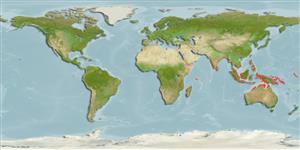>
Clupeiformes (Herrings) >
Dorosomatidae (Gizzard shads and sardinellas)
Etymology: Nematalosa: Greek, nema, -atos = filament + Latin, alausa = a fish cited by Ausonius and Latin, halec = pickle, dealing with the Greek word hals = salt; it is also the old Saxon name for shad = "alli" ; 1591 (Ref. 45335).
Eponymy: This is not a true eponym as it is named after a ship. [...] (Ref. 128868), visit book page.
Issue
Whether this species is chanpole is unclear.
Environment: milieu / climate zone / depth range / distribution range
Ecología
marino; agua dulce; salobre; anadromo (Ref. 51243). Tropical; 24°N - 0°, 73°E - 110°E (Ref. 188)
Distribución
Países | Áreas FAO | Ecosistemas | Ocurrencias, apariciones | Point map | Introducciones | Faunafri
Indo-West Pacific: southwest coast of India, presumably Bay of Bengal, off Andaman Sea coast of Thailand, Penang, Gulf of Thailand, Singapore and Viet Nam.
Tamaño / Peso / Age
Maturity: Lm ? range ? - ? cm
Max length : 16.3 cm SL macho / no sexado; (Ref. 188)
Espinas dorsales (total) : 0; Espinas anales: 0; Radios blandos anales: 17 - 26. Belly with 25 to 30 total scutes. Anterior arm of pre-operculum with the third infra-orbital bone immediately above it, no fleshy gap between. Lower jaw strongly flared outward. A pair of grooves in the spongy skin on top of head, converging posteriorly. Pectoral axillary scale present; hind edge of scales not toothed; a dark spot after gill opening followed by smaller spots on flank.
Inhabits marine waters, but enters (and presumably breeding in) freshwater (Ref. 4832). A filter-feeder. More data needed.
Life cycle and mating behavior
Madurez | Reproducción | Puesta | Huevos | Fecundidad | Larva
Whitehead, P.J.P., 1985. FAO Species Catalogue. Vol. 7. Clupeoid fishes of the world (suborder Clupeoidei). An annotated and illustrated catalogue of the herrings, sardines, pilchards, sprats, shads, anchovies and wolf-herrings. FAO Fish. Synop. 125(7/1):1-303. Rome: FAO. (Ref. 188)
IUCN Red List Status (Ref. 130435: Version 2024-1)
Threat to humans
Harmless
Human uses
Pesquerías: pesquerías de subsistencia
Herramientas
Special reports
Download XML
Fuentes de Internet
Estimates based on models
Preferred temperature (Ref.
123201): 27.6 - 29.2, mean 28.6 °C (based on 810 cells).
Phylogenetic diversity index (Ref.
82804): PD
50 = 0.5005 [Uniqueness, from 0.5 = low to 2.0 = high].
Bayesian length-weight: a=0.00871 (0.00415 - 0.01826), b=3.06 (2.89 - 3.23), in cm total length, based on LWR estimates for this (Sub)family-body shape (Ref.
93245).
Nivel trófico (Ref.
69278): 3.4 ±0.45 se; based on food items.
Resiliencia (Ref.
120179): Alto, población duplicada en un tiempo mínimo inferior a 15 meses (Preliminary K or Fecundity.).
Fishing Vulnerability (Ref.
59153): Low vulnerability (10 of 100).
